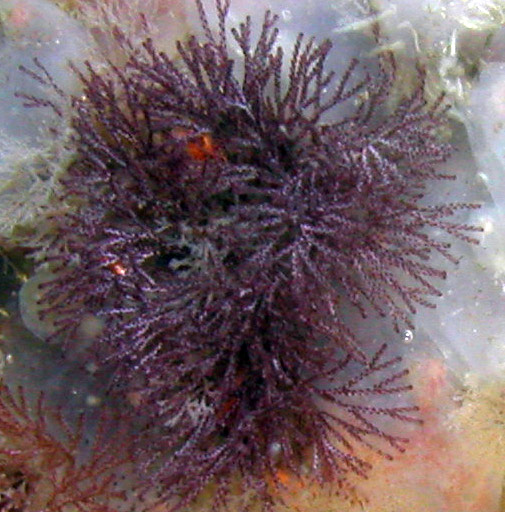Interactions
Bugula neritina is preyed upon by multiple organisms. Unspecified types of fish tend to eat the larvae while the adult colonies are preyed upon by nudibranchs, a type of sea slug (Cohen 2011).
Between 2-10 hours after being released from the ovicell, the larvae will settle on a hard substrate to begin to grow into the adult form (Cohen 2011). In addition, the substrate provides a firm support system to allow for attachment (Dahms et al. 2004). It was found in s study done by Walters in 1992, the structural complexity of the substrate effects how successful the organism is once it is settled. A small-scale complexity of a substrate is important for larvae that has just been released. On the contrary, medium to large-scale complexity is important for the growth of Bugula neritina. The larger complexity allows the organism to reach maturity so they can reproduce (Walters 1992).
Likewise, biofilms present on the substrate also influence larval settlement of Bugula neritina (Dahms et al. 2004). Biofilms are a thin layer of slimy bacteria that attach to a surface (Merriam Webster 2014). According to a study completed by Dahms, Dobretosov, and Qian, the highest level of larval settlement occur when there are biofilms of specific diatoms: Achnanthes sp., Amphora cofeaeformis, Amphora tennerrima, and Nitzschia constricta (check out more information on diatoms!) The substrates with biofilms of N. frustulum resulted in the lowest settlement of Bugula neritina. Moreover, the settlement of Bugula neritina negatively correlated with increasing densities of Pseudoalteromona which resulted in a much lower settlement of Bugula neritina larvae (Dahms et al. 2004).
 Bugula neritina
is also a prevalent organism in the fouling community,
meaning the organism attaches to artificial surfaces
(U.S. Naval Institution 1952). In addition to
attaching to hard substrates in its environment, it also
attaches to other surfaces such as the sides of docks,
buoys pilings, and boats. It can also attach to
other organisms such as seaweeds, sea grasses, sea
squirts, or other bryozoans (Cohen 2011).
Bugula neritina
is also a prevalent organism in the fouling community,
meaning the organism attaches to artificial surfaces
(U.S. Naval Institution 1952). In addition to
attaching to hard substrates in its environment, it also
attaches to other surfaces such as the sides of docks,
buoys pilings, and boats. It can also attach to
other organisms such as seaweeds, sea grasses, sea
squirts, or other bryozoans (Cohen 2011).
(Image of Bugula neritina attached to a rock)
Furthermore, Bugula neritina has a bacterial symbiont, Candidates endobugula sertula. Candidates endobugula sertula is responsible for producing bryostatins, a chemical extracted from Bugula neritina. Bryostatins have been found to have anti-cancer fighting agents. Moreover, there is also evidence that Bugula neritina needs to be fully supplemented with this symbiont in order to produce normal amounts of bryostatins (Davidson et al. 2001). See the Fun Facts page for more information on this topic.